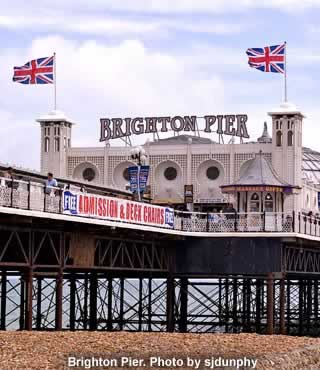Brighton |
|
 |
|||
One of Britain's most famous seaside towns |
||
Listen to this article |
||
Brighton is one of Britain's most famous seaside towns, just 47 miles away from London on the south coast. This relatively short distance has made it permanently popular for day trips, ever since the connecting railway was first introduced in the 1800s. Some tourists liked it so much that they decided not to go home at all - in fact, before the trains were brought in, Brighton was a quiet fishing town, home to only a few thousand people. Today, around two centuries later, its population has increased by 3500 percent! |
||
Its main attraction is of course the seafront, and Brighton Beach. On just about every warm day of the year, people from all over the country come here to eat ice cream, swim in the sea, or just relax with a book. More adventurous types of people may prefer to head just a little to the east, where they'll find the beach's nudist section! The sand is lined on one side with Brighton promenade, a long street full of shops, cafes, and art stalls. It's the perfect place to stock up on cold drinks and beach towels, before spending your day in the sun. |
||
Stretching out from the shore is Brighton Pier, over a hundred years old and still going strong. It's also known as "Palace Pier", so don't be confused! The 500-metre long structure houses numerous restaurants, arcades, and fairground rides. Just a little way along the beach is the even older West Pier - or at least, what's left of it. In recent years it has suffered from several serious fires, and at present lies in ruins. However, plans are in place for a new project here - a huge observation tower, designed by the creators of the London Eye. |
||
Another major landmark in the city is the Royal Pavilion, which was originally built for the use of King George IV. He was a huge fan of Brighton, and a frequent visitor, especially after his doctor told him that seawater would be good for his gout. The palace was built for him around 200 years ago, using an unusual Indian and Oriental-style design. Its ownership eventually passed on to Queen Victoria, who decided she didn't like it, and promptly sold it to the city of Brighton itself. It has since been renovated, and is open for public viewings. |
||
In addition to its beach, and local landmarks, Brighton has also become well-known for its shopping. It has a large proportion of small independent shops, which is unusual for a British city. The different areas in the town centre range from North Laine, which has a young, alternative vibe, to The Lanes, which is a great place to shop for antiques. |
||
In the springtime, though, the streets are full for a different reason. Every May, Brighton hosts the second largest arts and culture festival in the country, after Edinburgh. There are countless displays and performances of theatre, music, comedy and art, as well as many outdoor celebrations and parades. Other regular events include the "Great Escape" music festival, and September's Gay Pride carnival, which is the biggest in the UK. |
||
With so much going on, Brighton's worth a visit even when the sun isn't shining. But as soon as it does, take a hint from the locals - forget about whatever it is you're doing, and rush to the beach, as fast as you can! |
||
|
||
Royal Pavilion is open daily, 10am to 5pm. Entry costs around £10 for adults, £5.60 children. 4/5 Pavilion Buildings, Brighton, BN1 1EE. Tel: 03000 290900 |
||
|
Pocket Britain is optimised for use on a smartphone or tablet with internet access. All content is subject to copyright. All reasonable methods have been used to ensure information supplied is accurate at the time of publication. However, it is advisable to check information before relying on it. Privacy Policy |